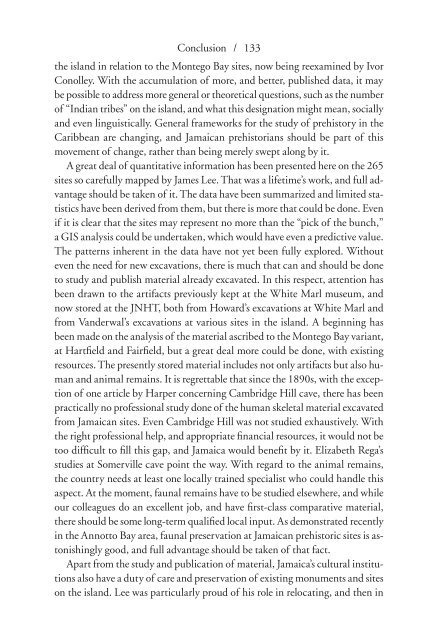Pre-Colombian Jamaica: Caribbean Archeology and Ethnohistory
by Phillip Allsworth-Jones
by Phillip Allsworth-Jones
You also want an ePaper? Increase the reach of your titles
YUMPU automatically turns print PDFs into web optimized ePapers that Google loves.
Conclusion / 133<br />
the isl<strong>and</strong> in relation to the Montego Bay sites, now being reexamined by Ivor<br />
Conolley. With the accumulation of more, <strong>and</strong> better, published data, it may<br />
be possible to address more general or theoretical questions, such as the number<br />
of “Indian tribes” on the isl<strong>and</strong>, <strong>and</strong> what this designation might mean, socially<br />
<strong>and</strong> even linguistically. General frameworks for the study of prehistory in the<br />
<strong>Caribbean</strong> are changing, <strong>and</strong> <strong>Jamaica</strong>n prehistorians should be part of this<br />
movement of change, rather than being merely swept along by it.<br />
A great deal of quantitative information has been presented here on the 265<br />
sites so carefully mapped by James Lee. That was a lifetime’s work, <strong>and</strong> full advantage<br />
should be taken of it. The data have been summarized <strong>and</strong> limited statistics<br />
have been derived from them, but there is more that could be done. Even<br />
if it is clear that the sites may represent no more than the “pick of the bunch,”<br />
a GIS analysis could be undertaken, which would have even a predictive value.<br />
The patterns inherent in the data have not yet been fully explored. Without<br />
even the need for new excavations, there is much that can <strong>and</strong> should be done<br />
to study <strong>and</strong> publish material already excavated. In this respect, attention has<br />
been drawn to the artifacts previously kept at the White Marl museum, <strong>and</strong><br />
now stored at the JNHT, both from Howard’s excavations at White Marl <strong>and</strong><br />
from V<strong>and</strong>erwal’s excavations at various sites in the isl<strong>and</strong>. A beginning has<br />
been made on the analysis of the material ascribed to the Montego Bay variant,<br />
at Hartfield <strong>and</strong> Fairfield, but a great deal more could be done, with existing<br />
resources. The presently stored material includes not only artifacts but also human<br />
<strong>and</strong> animal remains. It is regrettable that since the 1890s, with the exception<br />
of one article by Harper concerning Cambridge Hill cave, there has been<br />
practically no professional study done of the human skeletal material excavated<br />
from <strong>Jamaica</strong>n sites. Even Cambridge Hill was not studied exhaustively. With<br />
the right professional help, <strong>and</strong> appropriate financial resources, it would not be<br />
too difficult to fill this gap, <strong>and</strong> <strong>Jamaica</strong> would benefit by it. Elizabeth Rega’s<br />
studies at Somerville cave point the way. With regard to the animal remains,<br />
the country needs at least one locally trained specialist who could h<strong>and</strong>le this<br />
aspect. At the moment, faunal remains have to be studied elsewhere, <strong>and</strong> while<br />
our colleagues do an excellent job, <strong>and</strong> have first- class comparative material,<br />
there should be some long- term qualified local input. As demonstrated recently<br />
in the Annotto Bay area, faunal preservation at <strong>Jamaica</strong>n prehistoric sites is astonishingly<br />
good, <strong>and</strong> full advantage should be taken of that fact.<br />
Apart from the study <strong>and</strong> publication of material, <strong>Jamaica</strong>’s cultural institutions<br />
also have a duty of care <strong>and</strong> preservation of existing monuments <strong>and</strong> sites<br />
on the isl<strong>and</strong>. Lee was particularly proud of his role in relocating, <strong>and</strong> then in


















